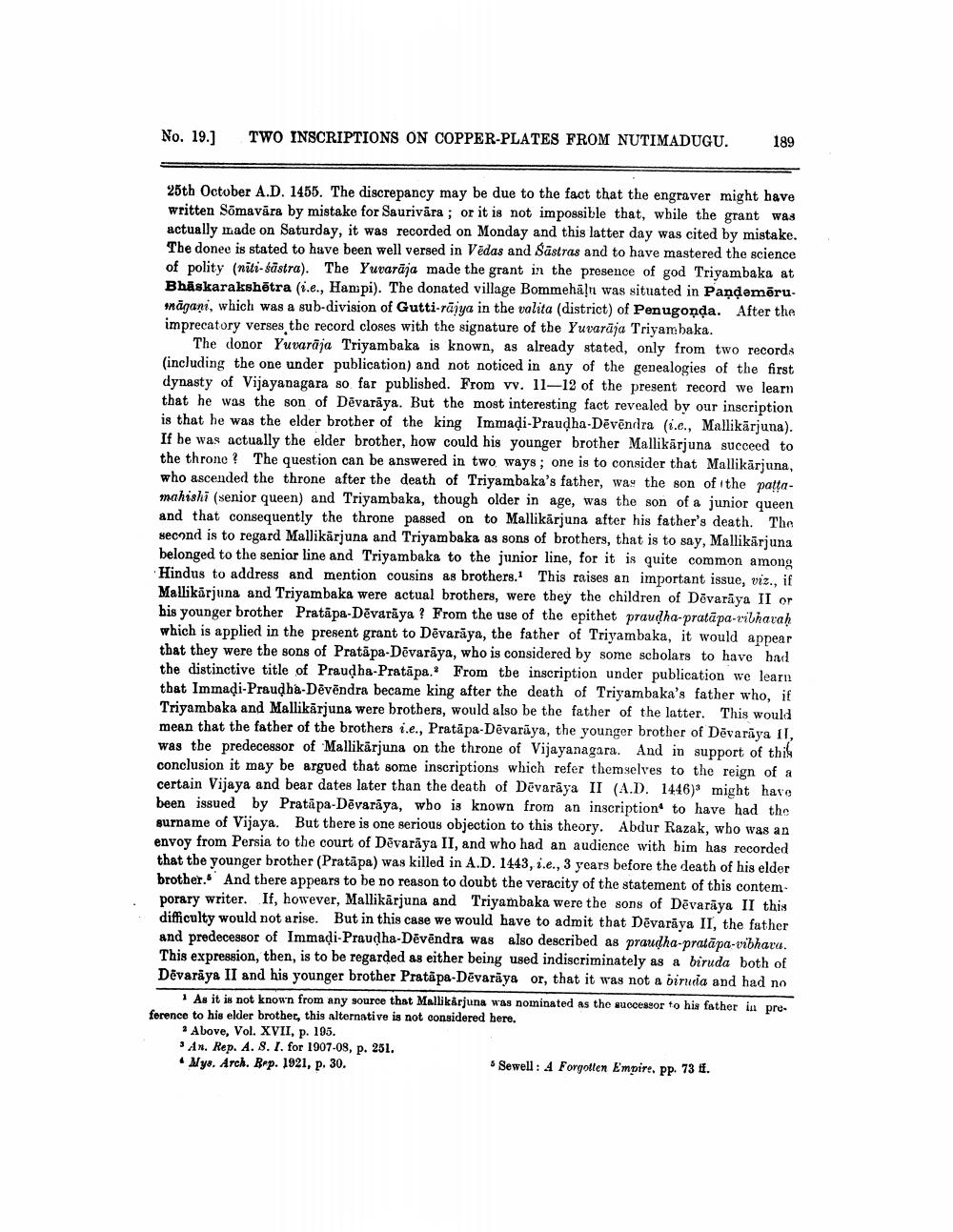________________
No. 19.]
TWO INSCRIPTIONS ON COPPER-PLATES FROM NUTIMADUGU.
189
25th October A.D. 1455. The discrepancy may be due to the fact that the engraver might have written Sõmavāra by mistake for Saurivāra ; or it is not impossible that, while the grant was actually made on Saturday, it was recorded on Monday and this latter day was cited by mistake. The donee is stated to have been well versed in Vēdas and Sāstras and to have mastered the science of polity (niti-sastra). The Yurarāja made the grant in the presence of god Triyambaka at Bhāskarakshētra (i.e., Hampi). The donated village Bommehāļn was situated in Pandemērusāgani, which was a sub-division of Gutti-rājya in the valita (district) of Penugonda. After the imprecatory verses the record closes with the signature of the Yuvarāja Triyambaka.
The donor Yuvarāja Triyambaka is known, as already stated, only from two records (including the one under publication) and not noticed in any of the genealogies of the first dynasty of Vijayanagara so far publisbed. From vv. 11-12 of the present record we learn that he was the son of Dēvarāya. But the most interesting fact revealed by our inscription is that he was the elder brother of the king Immadi-Praudha-Dēvëndra (.e., Mallikārjuna). If he was actually the elder brother, how could his younger brother Mallikārjuna succeed to the throne ? The question can be answered in two ways; one is to consider that Mallikarjuna, who ascended the throne after the death of Triyambaka's father, was the son of the pattamahishi (senior queen) and Triyambaka, though older in age, was the son of a junior queen and that consequently the throne passed on to Mallikarjuna after his father's death. The second is to regard Mallikarjuna and Triyambaka as sons of brothers, that is to say, Mallikärjuna belonged to the senior line and Triyambaka to the junior line, for it is quite common among Hindus to address and mention cousins as brothers. This raises an important issue, viz., if Mallikarjuna and Triyambaka were actual brothers, were they the children of Dövarāya II or his younger brother Pratapa-Dēvarāya ? From the use of the epithet praudha-pratāpa-ritharah which is applied in the present grant to Dēvarāya, the father of Triyambaka, it would appear that they were the sons of Pratāpa-Dēvarāya, who is considered by some scholars to have had the distinctive title of Praudha-Pratāpa. From the inscription under publication we learn that Immadi-Praudha-Dēvēndra became king after the death of Triyambaka's father who, if Triyambaka and Mallikarjuna were brothers, would also be the father of the latter. This would mean that the father of the brothers i.e., Pratāpa-Devarüya, the younger brother of Devaraya 11, was the predecessor of Mallikarjuna on the throne of Vijayanagara. And in support of this conclusion it may be argued that some inscriptions which refer themselves to the reign of a certain Vijaya and bear dates later than the death of Devaraya II (A.D. 1446)* might have been issued by Pratápa-Dēvarāya, who is known from an inscription to have had the surname of Vijaya. But there is one serious objection to this theory. Abdur Razak, who was an envoy from Persia to the court of Dēvarāya II, and who had an audience with him has recorded that the younger brother (Pratāpa) was killed in A.D. 1443, i.e., 3 years before the death of his elder brother. And there appears to be no reason to doubt the veracity of the statement of this contemporary writer. If, however, Mallikarjuna and Triyambaka were the sons of Dēvarāya II this difficulty would not arise. But in this case we would have to admit that Dēvarāya II, the father and predecessor of Immadi-Praudha-Dēvēndra was also described as praudha-pratāpa-vibhara. This expression, then, is to be regarded as either being used indiscriminately as a biruda both of Devaraya II and his younger brother Pratäpa-Dēvarāya or, that it was not a birudia and had no
1 As it is not known from any source that Mallikarjuna was nominated as the successor to his father in preference to his elder brother, this alternative is not considered here.
* Above, Vol. XVII, p. 195. * An. Rep. A. 8. I. for 1907-08, p. 251. • Wys. Arch. Rep. 1921, p. 30.
• Sewell: A Forgotten Empire, pp. 73 .




